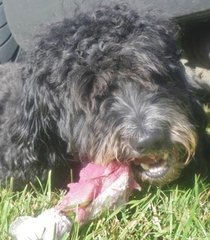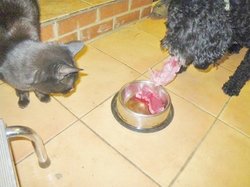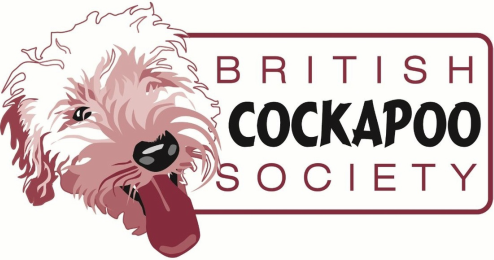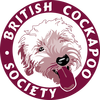WHAT TO FEED YOUR PUP

One of the things owners worry about is what to feed their dogs. There are so many makes and types of food available on the market now, that it can seem confusing.
There are lots of options. Do you want to do home cooked or commercially prepared? Dried food or raw? The information below can give some guidance but the main rule of thumb is buy the best quality your budget can afford.
Have a look at the labels of the dog food you are considering. The ingredient are listed in order of quantity, so the first on the list has more than the last on the list. All manufacturers will have their own recipe and some foods have a lot of fillers, additives and colourings and if possible it is best to avoid them.
They may also have animal or protein derivatives in the ingredients. These should be avoided if possible because it is a generic term which basically means that there are things like beaks, feathers, hooves etc. These ingredients have little or no nutritional benefit but are added to the food to bulk it out.
There is a site called allaboutdogfood which analysis and gives a star rating to dog foods so you can compare and see how much they all cost.
WET FOOD
Wet foods come in tinned, pouches or trays and again some are better than others. The good ones have a high percentage of meat, and vegetables. Look for one that has a high percentage of good protein and no artificial ingredients.
DRIED FOOD (Kibble)
Kibble is used by a lot of people, made by all the ingredients being minced or mashed together then dried and cooked. During the process the food may be sprayed with oils, flavourings, vitamins etc.
Look for one that has a high percentage of good quality protein, no additives or fillers, and no grains added. There are some good ones on the market and although these are a bit more expensive, you usually have to feed a smaller quantity because of the higher protein level.
ALWAYS ENSURE FRESH WATER IS AVAILABLE AS DRIED FOOD CAN MAKE DOGS THIRSTY
There are lots of options. Do you want to do home cooked or commercially prepared? Dried food or raw? The information below can give some guidance but the main rule of thumb is buy the best quality your budget can afford.
Have a look at the labels of the dog food you are considering. The ingredient are listed in order of quantity, so the first on the list has more than the last on the list. All manufacturers will have their own recipe and some foods have a lot of fillers, additives and colourings and if possible it is best to avoid them.
They may also have animal or protein derivatives in the ingredients. These should be avoided if possible because it is a generic term which basically means that there are things like beaks, feathers, hooves etc. These ingredients have little or no nutritional benefit but are added to the food to bulk it out.
There is a site called allaboutdogfood which analysis and gives a star rating to dog foods so you can compare and see how much they all cost.
WET FOOD
Wet foods come in tinned, pouches or trays and again some are better than others. The good ones have a high percentage of meat, and vegetables. Look for one that has a high percentage of good protein and no artificial ingredients.
DRIED FOOD (Kibble)
Kibble is used by a lot of people, made by all the ingredients being minced or mashed together then dried and cooked. During the process the food may be sprayed with oils, flavourings, vitamins etc.
Look for one that has a high percentage of good quality protein, no additives or fillers, and no grains added. There are some good ones on the market and although these are a bit more expensive, you usually have to feed a smaller quantity because of the higher protein level.
ALWAYS ENSURE FRESH WATER IS AVAILABLE AS DRIED FOOD CAN MAKE DOGS THIRSTY

RAW FEEDING
A growing number of people are deciding to feed their dogs a completely raw diet, often referred to as a BARF diet (Bones And Raw Food) The raw feeding regime will vary from person to person according to their individual preferences. Some will feed mainly meat and bones, others will add things like fish, eggs and vegetables, or sometimes it is based more round commercial raw meat that is available from pet shops and other suppliers online. There is no hard and fast rule about it.
Many people are wary about giving their dogs raw bones to chew on and like to start off using the commercial raw meat suppliers who provide mince and frozen meats, which often contain ground up bone for calcium but for those wanting to give bones chicken wings are a good starting point.
The ratio for feeding is usually 80/10/10 - that is 80% protein (chicken, turkey, fish etc), 10% bones and 10% offal (liver, kidney etc). The amount fed depends on the weight of the dog and about 2-3% of the adult weight, or expected adult weight of the dog.
NEVER give a dog cooked bones!!
To find out more search read our RAW FEEDING page or join one of the many raw feeding groups that can be found on Facebook or online.
A growing number of people are deciding to feed their dogs a completely raw diet, often referred to as a BARF diet (Bones And Raw Food) The raw feeding regime will vary from person to person according to their individual preferences. Some will feed mainly meat and bones, others will add things like fish, eggs and vegetables, or sometimes it is based more round commercial raw meat that is available from pet shops and other suppliers online. There is no hard and fast rule about it.
Many people are wary about giving their dogs raw bones to chew on and like to start off using the commercial raw meat suppliers who provide mince and frozen meats, which often contain ground up bone for calcium but for those wanting to give bones chicken wings are a good starting point.
The ratio for feeding is usually 80/10/10 - that is 80% protein (chicken, turkey, fish etc), 10% bones and 10% offal (liver, kidney etc). The amount fed depends on the weight of the dog and about 2-3% of the adult weight, or expected adult weight of the dog.
NEVER give a dog cooked bones!!
To find out more search read our RAW FEEDING page or join one of the many raw feeding groups that can be found on Facebook or online.

